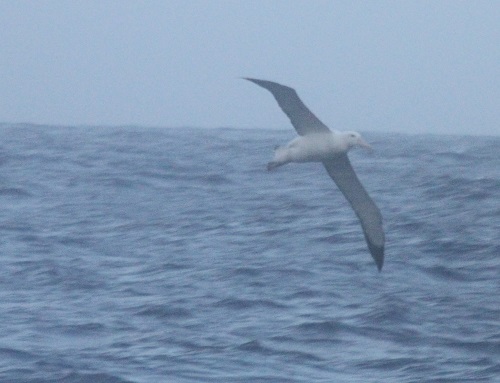We’re still transiting. It’s starting to get cold! No sea ice yet though. We got a little bit of calmer weather yesterday, just enough to give me the time to get outside behind the bridge and snap a few pictures (and a quick selfie) before the weather picked up again.
 Dominique Richardson behind the Bridge of the NBP during a break in the stormy weather.
Dominique Richardson behind the Bridge of the NBP during a break in the stormy weather.
As I was out behind the bridge, I also attempted to snap a few pictures of a visitor I’ve been seeing around the ship. It’s not often you get visitors on a ship in the middle of the ocean, but for the past few days a wandering albatross has been circling the ship. This is the first live albatross I’ve ever seen and it is massive. I wish these pictures could convey how large he is, but the second I would pull out my camera he would fly as far away from the ship as he could while still technically circling it (and then return to circling nice and close when I would go back inside).
 A camera shy wandering albatross circling the NBP.
A camera shy wandering albatross circling the NBP.
And here’s what it’s supposed to look like:
 Wandering albatross in flight. Wikipedia.
Wandering albatross in flight. Wikipedia.
Wandering albatross (Diomedea exulans) are huge sea birds that can cover the entire range of the Southern Ocean. Their wingspan, which is the largest of any bird, can be up to 11ft 6in (though a few larger specimens have been recorded). With their huge wings, they spend hours gliding before they have to flap at all. They spend most of their life in the air, landing only to eat and breed. It’s hard to tell how far they travel in a year, but one wandering albatross was recorded having flown almost 4,000 miles in just about two weeks!
These birds feed at night, eating cephalopods like squid, small fish and crustaceans. Occasionally some albatross have been known to eat so much they can’t fly and have to float on the surface of the water until they can take off again. I haven’t seen our visitor eat yet, mostly just circle the boat repeatedly (which they’re known to do).
In some cultures having a wandering albatross around is a good omen, though the old saying “having an albatross around your neck” implies you have some sort of burden (…this “burden” may be trying to get a decent picture of the bird…). Since these albatross are a vulnerable species, I’m going to take having this one around as a good sign!
Hopefully we’ll have another lull in the rough weather again soon so I can make another attempt at getting some decent photos of the bird before it leaves us.


Comments